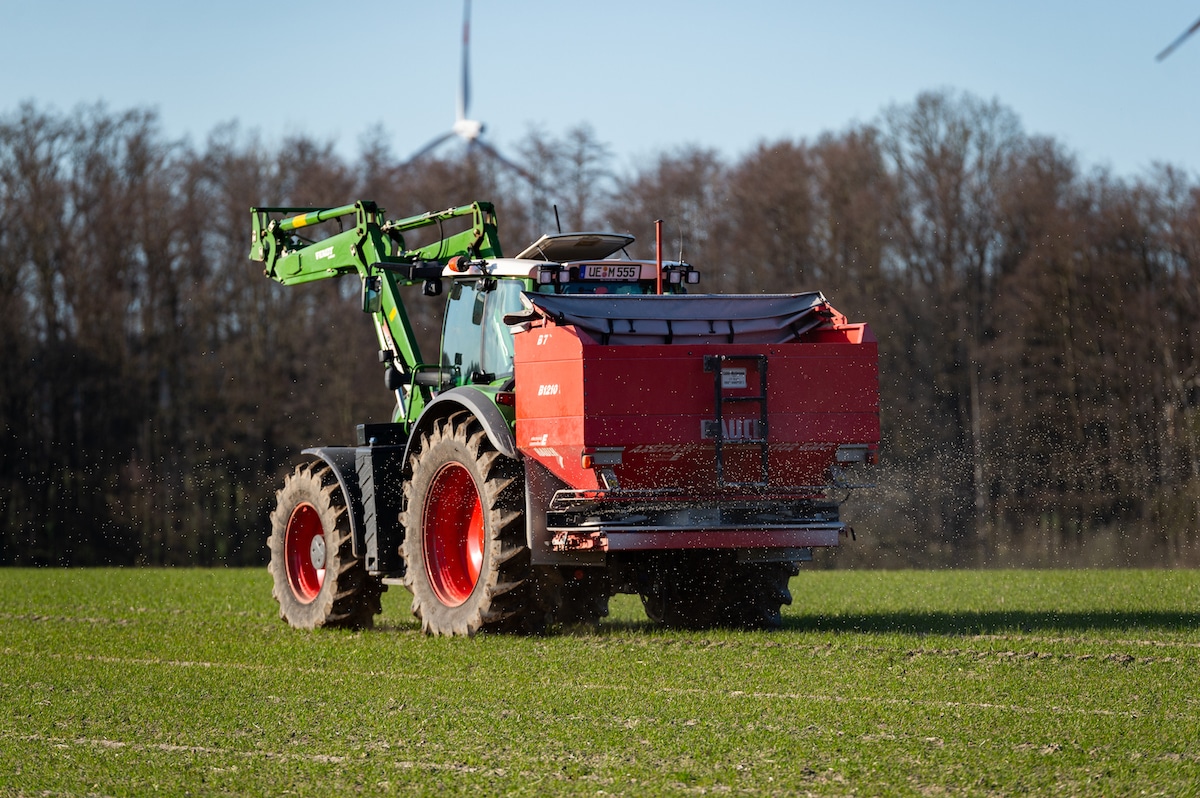Products You May Like
A farmer applies nitrogen fertilizer to a field in Lower Saxony, Hansted, Germany. Philipp Schulze / picture alliance via Getty Images

Why you can trust us
Founded in 2005 as an Ohio-based environmental newspaper, EcoWatch is a digital platform dedicated to publishing quality, science-based content on environmental issues, causes, and solutions.
When we think of greenhouse gas emissions, we typically think of coal-burning power plants, vehicle exhaust or maybe forests being cleared to make way for methane-belching cows.
However, there is another important agricultural source of climate pollution: nitrogen-based fertilizers. A new study from University of Cambridge-based researchers has calculated these fertilizers’ total contribution to the climate crisis for the first time, but also revealed how that contribution could be reduced to around a fifth of current levels by 2050.
“Our work gives us a good idea of what’s technically possible, what’s big, and where interventions would be meaningful — it’s important that we aim interventions at what matters the most, in order to make fast and meaningful progress in reducing emissions,” study co-author Dr. André Cabrera Serrenho from Cambridge’s Department of Engineering said in a press release.
Nitrogen fertilizers can be either organic — coming largely from plant or animal waste — or synthetically made using chemical processes, according to Carbon Brief. Both have been important for boosting food production worldwide — environmental scientist professor Vaclav Smil called them “the most important invention of the 20th century.”
More From EcoWatch
However, they are causing environmental problems in the 21st. When they are sprayed onto a field of crops, they can acidify the soil, run off into nearby waterways and feed deadly algal blooms or interact with soil microbes to form nitrous oxide (N2O), which is a greenhouse gas almost 300 times as potent as carbon dioxide. Their production also burns emissions and, together with plastics, synthetic fertilizers make up as much as 74 percent of the products of the petrochemical industry, according to the press release.
Despite this, a full life cycle assessment of fertilizer emissions had not been conducted before the new research published in Nature Food Thursday. What the study found was that nitrogen fertilizers contribute around five percent of global greenhouse gas emissions. Organic and synthetic fertilizers emit more than global shipping and aviation put together at around 2.6 gigatonnes of carbon each year, according to the press release.
The researchers further discovered that around two-thirds of these emissions occurred after the fertilizers had been spread over crops.
“It was surprising that this was the major source of emissions,” Serrenho said in the press release. “But only after quantifying all emissions, at every point of the lifecycle, can we then start looking at different mitigation methods to reduce emissions without a loss of productivity.”
The researchers assessed what would happen if various already-available methods to reduce fertilizer emissions were put in place. For example, fertilizer production could be powered with renewable or nuclear energy. Nitrification inhibitors could also be added to block the formation of nitrous oxide. However, the most important intervention would be to prevent fertilizers from being over applied.
“Increasing nitrogen-use efficiency is the single most effective strategy to reduce emissions,” the study authors wrote in their abstract.
Currently, only 42 percent of the nitrogen applied to a field is actually absorbed by the crops, Carbon Brief explained. If that were increased to 67 percent, demand for fertilizers could fall by 48 percent by 2050. If farmers worldwide applied all of the strategies outlined in the report, nitrogen emissions could fall by 84 percent.
Professor Mark Sutton, an environmental physicist at the UK Centre for Ecology and Hydrology, applauded the study for showing a way forward. He also said it came at an opportune time, because the participants at the COP15 biodiversity summit in Montreal in December of 2022 agreed to cut nutrient loss in half by 2030.
“I think what is really new [in the study] is this very high level of saying ‘we can do it,’ and that’s why it’s a challenge to the community, for people who say we can’t go quite as far as this,” he told Carbon Brief. “I’ve not seen the whole set of emissions from all sources combined showing that level of ambition.”
Subscribe to get exclusive updates in our daily newsletter!
By signing up, you agree to the Terms of Use and Privacy Policy & to receive electronic communications from EcoWatch Media Group, which may include marketing promotions, advertisements and sponsored content.
